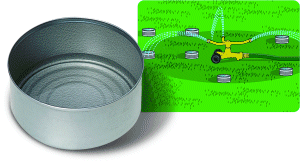When we are not in drought restrictions (stages 1 through 4), under Year-Round rules you are allowed to water your landscape with a sprinkler any day of the week midnight – 10 a.m. or 9 p.m. – midnight. Watering by hand-held hose or with a 5-gallon bucket is allowed any time. However, water waste is prohibited at all times.
Watering Rules
- You may use a sprinkler to water any day of the week midnight – 10 a.m. or 9 p.m. – midnight. (However, you can still water outdoors by hand at any time.)
- Do not allow water to run off the lawn into the street. It is considered water waste and subject to ticketing.
You can call 210-704-SAWS and press the option for “Water Waste” when you hear the prompt, or you can report water waste online. The person who answers the call will take a report so someone can follow up.
If the water waste is happening during SAWS business hours (7:45 a.m. – 5 p.m.), you can also call the Conservation Department directly at 210-704-SAVE to discuss the problem you are seeing.
We appreciate your help!
We do not have Water Officers on standby at all hours. Instead, we follow up with the location you have described by finding the responsible party and making certain that he or she is fully aware of the rules. Most people correct the problem with this intervention. If water waste is observed by the officers, the site will receive a ticket.
The city of San Antonio sets the rules for water waste regardless of who supplies the water to a site. Therefore, well users and users of other water companies who reside in the City of San Antonio are subject to the rules and consequences. Many other communities around San Antonio have adopted similar rules for water waste.
Watering Efficiently
Make sure your system is operating correctly. Keep sprinkler heads adjusted to spray appropriate landscape areas, and have your irrigation contractor check the system at least once every year. Next, review our advice on how much water to use with your hose or in-ground sprinkler system.
Apply enough water to fill the whole soil profile. However, for personalized landscape watering advice, you may want to sign up for our Garden Style San Antonio e-newsletter. Every issue features advice from local horticulture experts on what to plant, when to fertilize and how to attract wildlife to your landscape.
It is more efficient to give your dry spots attention with hand-held hoses rather than running your whole system. Home irrigation systems use between 1,500-3,000 gallons (or more for larger properties) each time they run.
Established trees and shrubs, such as those on the SAWS recommended plant list, do not need supplemental irrigation. They can survive dry periods well.
In San Antonio, water your lawn once per week to develop deep roots and grass capable of taking advantage of the rain when it comes.
Water needs vary greatly by season, grass species and amount of shade, so keeping the same settings year-round will result in too much watering. As a general rule, three-fourths of an inch of water per week on St. Augustine or Zoysia grasses that are in full sun is sufficient in the summer. In the shade, these species only need one-half of an inch of water per week. Bermuda grass and buffalo grass, both of which can only grow in full sun, require one-half of an inch per week. In the fall, spring and winter, these recommendations can be reduced or eliminated, depending on the weather. As a reminder, the Garden Style San Antonio e-newsletter is an added value for our customers.
To know how long to water, measure your sprinkler application rate. Put out several shallow, straight-sided containers (tuna cans, Tupperware, cake pans, etc.) before watering. Water for 20 minutes and then check the depth of the water in your containers. Estimate the average of the depth to see how much water you put down in 20 minutes. Every system is different, so it is important to measure.

Sprinklers that spray water parallel to the ground instead of up in the air are more efficient. You will lose less water to evaporation.
Both soaker hoses and drip irrigation are best for flower beds, vegetable gardens and newly planted trees and shrubs. Soakers like the black rubber model and the flat, green spray model work well in most situations. Drip irrigation has a pressurized thick plastic or rubber tube with evenly spaced emitters.
Water from the soaker hose will spread out to the side of the hose and seep deeply into the soil profile when it is applied slowly. If it is applied too quickly, it may run off and not penetrate to the roots that need it. To accomplish this effect, turn your hose faucet only a quarter turn and observe the hose to see that it is slowly seeping along its length. Soaker hoses should not exceed 100 feet in length. If many soaker hoses are connected in a series, the water will not be distributed to the end of the hose. Finally, never hook a soaker hose directly to the faucet but to another hose that is then connected to the faucet.

